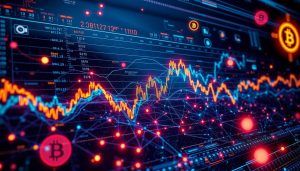Ethereum gas fees often soar at 9 a.m. in New York. This is when transaction costs are at their peak. It happens as more people trade on exchanges like Coinbase and Binance. The spike matches the U.S. stock market’s opening hours1. Knowing when not to buy altcoins can save you money. It helps you avoid high prices and extra fees.
Today, there are over 15,000 cryptocurrencies2. Timing your investment is key. Whether you’re a beginner or a pro, understanding the worst times to invest is crucial. It protects you from losses and improves your investment approach. Such knowledge is vital in the unpredictable world of cryptocurrency.
Picking the right time to buy isn’t just about the clock. You need to understand market cycles and behavior. For example, altcoin prices may change a lot during U.S. stock market hours1. That’s when Bitcoin trading is also high. This shows why buying strategically is better than making quick decisions.
Altcoin buying strategies require careful thought but can be very rewarding. This article explores the worst times for buying altcoins. It also shares smarter alternatives to guide you in the complex world of cryptocurrencies.
Key Takeaways
- Ethereum gas fees peak during U.S. trading hours, primarily around 9 a.m. in New York.
- Major centralized exchanges see increased trading activity that influences altcoin prices.
- Bitcoin spot volume surges with U.S. stock market openings, affecting the entire market.
- The cryptocurrency market features approximately 15,000 individual cryptocurrencies, emphasizing the need for careful timing and selection.
- Market sentiment heavily drives altcoin prices, requiring strategic investment approaches.
Understanding Altcoins: What You Need to Know
Altcoins include all cryptocurrencies besides Bitcoin. They’ve changed a lot since their start in 2011. People are interested in their new technologies and uses. It’s important to know about them if you’re thinking of adding them to your cryptocurrency mix.
Definition and Evolution of Altcoins
Altcoin” means any crypto that isn’t Bitcoin. They came about in 2011, two years after Bitcoin. Early ones like Namecoin wanted to solve unique problems, like making a system for domain names that no one controls3. Now, there are thousands of altcoins, each improving in some way. For example, some are faster and cheaper than Bitcoin3.
Types of Altcoins: Mining-based, Stablecoins, Security Tokens, Memecoins
Altcoins come in different kinds:
- Mining-based: These need a lot of energy to check transactions3.
- Stablecoins: They stick to stable things like the U.S. dollar to keep their value even3.
- Security Tokens: These are like owning a part of something real, like stocks or houses. They’re a new way to invest4.
- Memecoins: Started mostly for fun, they can still become really valuable. Dogecoin is a famous one4.
Popular Altcoins by Market Capitalization
Some altcoins stand out due to their size and usefulness. Ethereum started in 2015 and leads in apps that don’t need any middleman and smart contracts3. BNB helps you get discounts on Binance, a big trading place. Solana offers quick and cheap transactions. The crypto market was worth about $449.3 billion in 2018 and keeps growing. This shows how big an impact these altcoins have4.
The Worst Times to Buy Altcoins (And What to Do Instead)
Buying altcoins when the market is down can really hurt your wallet. Knowing when not to buy can save you from big losses. Let’s look at when you should avoid buying and make smarter moves instead.
Market Highs and Price Peaks
Buying altcoins when prices are sky-high is risky. Many traders get excited when the market is up. But they can lose money when prices suddenly fall. The Bitcoin Halving in 2020 saw a big price jump. Prices went up 17% before the event and 559% after. But, purchasing altcoins at such high points can make you lose money when prices drop5. A better plan is to buy altcoins a few months before or after big events like the Bitcoin Halving6.
Identifying Market Manipulation and Pump-and-Dump Schemes
Market manipulation and pump-and-dump scams can be a big danger in the altcoin world. These scams make an altcoin’s price soar quickly, then fall hard. This can make traders lose a lot of money. Altcoins might go up 400%-500% quickly, and then crash by 80%7. Spotting these scams takes careful watching and studying. Use smart strategies like stop orders to lower your risks7.
The Risks of Buying During Market Hype
Prices of altcoins can inflate fast because of social media buzz. But when the excitement dies down, prices can plummet. Taking part in the hype often leads to losses later. It’s wise to wait and not rush into buying. Look for solid altcoin projects that are truly valuable instead.
Common Altcoin Trading Mistakes to Avoid
In the unpredictable world of altcoin trading, knowing what mistakes to avoid is key. By keeping these errors in mind, you can develop better cryptocurrency market strategies. This will help strengthen your altcoin trading strategies for future success.
Falling for FOMO (Fear of Missing Out)
FOMO is a big challenge in altcoin trading. Many traders make quick buys fearing they’ll miss out, only to face losses later. In 2021, scammers took $10 billion in cryptocurrency from investors. This amount reduced to $4.6 billion in 20238. The best strategy is to wait for the market to calm and do your homework before investing.
Ignoring Fundamental Analysis
Some traders skip doing fundamental analysis, which is a mistake. Not looking into an altcoin’s tech, team, and market potential can lead to bad investment choices. It’s crucial to assess these fundamentals before using any altcoin trading strategies. Remember, thorough analysis is vital for success in various industries9.
Overleveraging Investments
Leverage can increase wins and losses in crypto trading. If the market goes against you, it can lead to big losses8. Some beginners, hoping to get rich quick, use too much leverage and can lose a lot. Experts recommend risking only 1-2% of your account per trade to lower losses9. It’s crucial to use leverage wisely to prevent big mistakes.
Neglecting Security Measures
Securing your trading is very important. With billions stolen in scams in recent years8, strong security practices are a must. Online wallets are handy but riskier than hardware wallets. Make sure to use safe storage and always double-check wallet addresses before making moves. Good security habits are key to protecting your funds.
Altcoin Market Analysis: Indicators to Watch
To understand the altcoin market well, you need to know about different indicators. Using technical analysis tools, checking social media trends in crypto, and knowing network activity help make a good strategy for analyzing altcoins.
Technical Analysis Tools
Technical analysis is key for traders. It uses price charts and graphs to spot trends and chances to trade. Tools like moving averages, candlestick patterns, and the Relative Strength Index (RSI) are important. Even when September brings lower prices in crypto, picking good altcoins is crucial10. Looking for coins with a strong story and doing well compared to the market is smart10.
Sentiment Analysis and Social Media Trends
Sentiment analysis looks at social media to understand the market’s mood and predict price changes. Tracking social media trends in crypto reveals the public’s feelings and possible big news. Analysts say it’s better to focus on coins with good stories than to try and time the market10. They also look forward to good news for altcoins by late 2025, hoping for economic changes like lower interest rates from the US Federal Reserve10.
Network Activity and Development Updates
Keeping up with network updates is vital for altcoin analysis. Looking at things like how fast transactions happen, how scalable a network is, and its overall health shows if an altcoin will last. For example, Solana (SOL) can handle a lot of transactions very fast, challenging Ethereum11. Also, Avalanche (AVAX) has a limited supply and burns fees, making it attractive to investors11. These details help predict an altcoin’s growth.
By using these different indicators, you can make better investment choices in the changing altcoin market.
Altcoin Price Trends and Historical Data
Understanding altcoins and their price trends is key for anyone investing in cryptocurrency. It helps to look at seasonal trends, how market cycles work, and how prices relate to Bitcoin. This knowledge leads to smarter investment choices.
Seasonal Trends in Cryptocurrency Markets
Seasonal trends are big in crypto. For example, August and September often see lower Bitcoin prices, with drops of -7.8% and -5.6% since 201312. The last quarter of the year, however, usually brings gains across the market. Bitcoin starts the rally, and altcoins often follow.
Impact of Market Cycles on Altcoins
Altcoins usually hit their high at the bull market’s end, showing more ups and downs than Bitcoin12. Sometimes, altcoins shoot up way more than Bitcoin13. Yet, with so many altcoins now, not all will see big price jumps. The market goes through phases. There’s a testing period that tries investor patience, only to lead to momentum gain later12.
Price Correlations with Bitcoin
The link between altcoin and Bitcoin prices helps forecast market trends. Often, altcoins lag at first but catch up as investors move from Bitcoin to riskier options12. Ethereum, for instance, made a big splash despite early issues, thanks to solid marketing14. Watching these patterns can guide altcoin investment decisions. Plus, as Bitcoin’s stock/flow ratio rises, it remains a crucial marker for altcoin performance14.
When to Avoid Buying Altcoins: Red Flags to Watch For
Investing in altcoins requires caution and the ability to spot red flags is key. Be cautious of overpriced coins, limited trading options, sudden price jumps, and legal issues. Here are tips to keep away from risky altcoin investments.
Signs of Overvaluation
Overvaluation is a major worry when picking altcoins. If coin prices are up with no real support, that’s a red sign. Look out for projects lacking a detailed whitepaper and strong economic plans; they’re often priced more than their value. A missing whitepaper means less clarity for you, making it hard to judge the coin’s worth15. Also, coins that don’t live up to their promised features show overpricing15. Be alert if Token Sniffer scores are low or nil, as it may point out problems like too much control in few hands15.
Poor Liquidity and High Volatility
Watch out for altcoins that are tough to trade or whose prices move wildly. Coins hard to sell or buy without affecting their price pose big risks. For some altcoins, what you see in computing power doesn’t match the total, with a large part hidden. This could allow someone to dominate the block’s creation16. Coins that don’t see much price change may not attract traders, leading to them getting dropped by exchanges15.
Regulatory and Legal Challenges
Legal and regulatory hurdles are serious concerns for some altcoins. Projects with anonymous creators are risky as they might vanish after collecting funds15. The market’s mood, seen through tools like the Crypto Fear and Greed Index, is crucial17. Tough laws can mean big fines or even bans, impacting these projects and your investment.
For insights on when to invest and other tips, check out timing strategies and market correction investing on CryptoSy.
Best Time to Invest in Altcoins: Timing Strategies
Finding the right moment to invest in altcoins can really change your profits. Strategies like dollar-cost averaging, buying during market dips, and making the most of bull markets can boost your returns. They also help you avoid the pitfalls of bad timing.
Dollar-Cost Averaging (DCA)
Dollar-cost averaging (DCA) means putting in a steady amount of money regularly, not trying to guess prices. This method is great for dealing with the ups and downs of altcoin markets. It makes the emotional rollercoaster of highs and lows easier to handle. This stability leads to better results over time. For instance, consistently investing in Bitcoin with DCA could result in a top gain of 1,100%, or an average of 175%, showing how powerful this approach is18.
Investing During Market Corrections
Buying during market corrections can be smart. When prices fall sharply, it might be your chance to buy low and sell high later. A study showed buying cryptos at month-end could be wise. Prices usually go up in the first 10 days, then drop later19. This method, known as market correction investing, uses these dips for future profit.
Capitalizing on Bull Runs
Taking advantage of bull runs can lead to big earnings. Key events, like Bitcoin ETF approvals and big investors stepping in, often start these rallies18. Remember, it’s key to know a true bull run from just hype to avoid losses. Data since 2015 shows investments can grow by as much as 1,100%, or average around 175%20.
Knowing these strategies and using them when you invest in altcoins can help you find the best times to buy. This way, you can improve your chances of high returns.
Smart Alternatives to Buying Altcoins: Other Investment Strategies
Looking for other options besides buying altcoins? Check out staking, yield farming, and investing in stablecoins. These approaches not only add variety to your investment mix but also open up new ways to earn returns in the fast-changing world of cryptocurrency.
Staking and Yield Farming
With staking, you can earn rewards by keeping your cryptocurrencies in a wallet for a set time. Platforms like Ethereum and Cardano have staking opportunities that could give you more rewards the longer you commit your assets21. Meanwhile, yield farming lets you lend your assets to decentralized finance (DeFi) protocols and earn interest or rewards. This could be very profitable, but it’s not without risks, like the chance of smart contract flaws.
Investing in Stablecoins for Stability
If stable investments interest you, Tether (USDT) and USD Coin (USDC) are great picks. They’re huge in the market, worth $119 billion and $36 billion, and are tied to the US Dollar for stability21. This makes them a good choice in unpredictable markets. Adding stablecoins to your mix can protect you from the crypto market’s ups and downs.
Exploring Tokenized Assets
Tokenized assets are a fresh investment idea in cryptocurrency. They turn real-world items like property, art, and gold into digital versions you can invest in. With platforms like Securitize and tZERO, investing in these assets is easy. Including tokenized assets in your portfolio could lower your overall risk and give you a taste of different markets.
These options—staking, yield farming, investing in stablecoins, and exploring tokenized assets—provide diverse ways to make money in the crypto sector. They could better fit your risk level and investment aims. But, always do your homework and keep an eye on the market when trying out these strategies. For new updates and in-depth analysis, follow trusted sources and the latest industry news.
Altcoin Investment Advice: Tips for New Traders
Starting in the altcoin market might seem tough, but knowing what to do helps a lot. Here are some useful pointers for anyone beginning with altcoins.
Researching and Diversifying Your Portfolio
It’s vital to research before diving into altcoins. Learn about the technology, the team, and their future plans. This approach helps find altcoins with a chance to grow22.
Spreading your investments is also key. By putting your money in various altcoins, you lower the risk. Including main cryptos like Bitcoin and Ethereum with other promising altcoins balances risks23. In Altcoin Season, not all altcoins do well, but diversification helps reduce losses22.

Setting Realistic Expectations and Goals
Having clear goals is important in the unpredictable altcoin world. While altcoins can grow your investment quickly, they’re riskier than Bitcoin24. Understand that fast profits aren’t guaranteed. Using strategies like dollar-cost averaging, looking at market history, and planning long-term can lead to consistent growth. Patience is vital in seeing success in crypto investments23.
Leveraging Educational Resources and Communities
Keeping up-to-date is necessary in the altcoin scene. Use online courses, webinars, and blogs to learn more. Being part of crypto communities through social media or forums offers valuable tips and news22.
Tools for fundamental and technical analysis improve your trading choices, keeping you informed about current trends. Following dependable news and industry updates helps avoid bad decisions23.
For detailed advice on understanding cryptocurrency investing, check out this handy guide24.
Conclusion
As we wrap up, it’s crucial to emphasize the value of smart altcoin investing. Being smart means knowing the worst times to buy altcoins and avoiding common mistakes. This improves your chances of doing well with investments. For example, Chainlink dropped 89% from its highest price of $5225.
Talking about smart investing, timing matters a lot. It’s good to buy when prices are low, like during a bear market. The COVID crash showed us this when Bitcoin fell to $3,000 then climbed back up25. But, ensure your investments match your risk level and financial ability25.
Finally, think about making your investment mix diverse by trying staking, yield farming, or other assets such as real estate and stocks. While altcoins offer chances for growth, they have their risks too. Keeping up with the future of altcoins is key. These tips can help you move through the cryptocurrency world more skillfully.
























 Bitcoin
Bitcoin  Ethereum
Ethereum  Tether
Tether  XRP
XRP  Solana
Solana  USDC
USDC  Lido Staked Ether
Lido Staked Ether  TRON
TRON  Dogecoin
Dogecoin  Cardano
Cardano  Figure Heloc
Figure Heloc  WhiteBIT Coin
WhiteBIT Coin  Wrapped stETH
Wrapped stETH  Bitcoin Cash
Bitcoin Cash  Wrapped Bitcoin
Wrapped Bitcoin  Chainlink
Chainlink  USDS
USDS  Hyperliquid
Hyperliquid  Binance Bridged USDT (BNB Smart Chain)
Binance Bridged USDT (BNB Smart Chain)  LEO Token
LEO Token  WETH
WETH  Stellar
Stellar  Wrapped eETH
Wrapped eETH  Monero
Monero  Ethena USDe
Ethena USDe  Coinbase Wrapped BTC
Coinbase Wrapped BTC  Zcash
Zcash  Litecoin
Litecoin  Avalanche
Avalanche  Sui
Sui  Hedera
Hedera  Shiba Inu
Shiba Inu  Dai
Dai  sUSDS
sUSDS  World Liberty Financial
World Liberty Financial  Cronos
Cronos  USDT0
USDT0  Toncoin
Toncoin  PayPal USD
PayPal USD  Uniswap
Uniswap  Polkadot
Polkadot  Ethena Staked USDe
Ethena Staked USDe  Mantle
Mantle  Aave
Aave  Bittensor
Bittensor  USD1
USD1  Canton
Canton  Bitget Token
Bitget Token